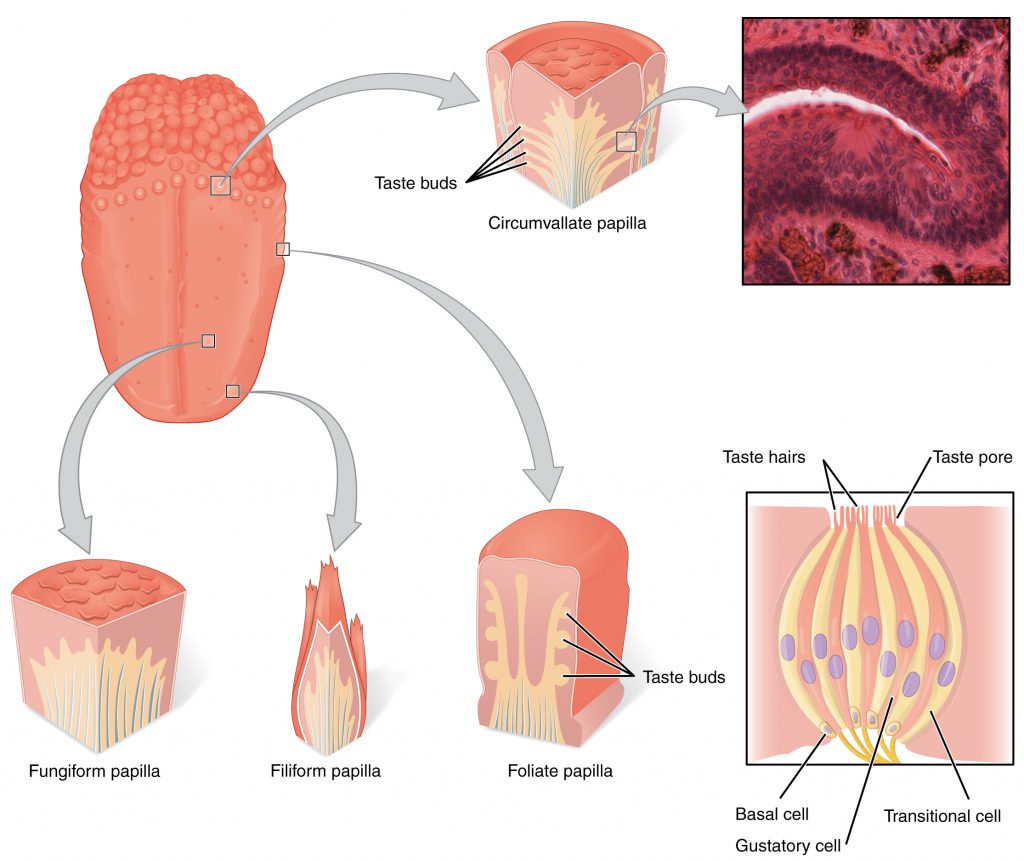Taste and Smell
35 The Structure of the Tongue
Learning Objectives
Know the difference between a taste bud and a papilla.
Be able to name the different kinds of papillae.
Gustation is the special sense associated with the tongue. The surface of the tongue, along with the rest of the oral cavity, is lined by a stratified squamous epithelium. Raised bumps called papillae (singular = papilla) contain the structures for gustatory transduction. There are four types of papillae, based on their appearance: circumvallate, foliate, filiform, and fungiform (Fig 4.4.1).
- Filiform papillae are thread-like structures on the tongue that aid in manipulating food, particularly in carnivores.
- Fungiform papillae resemble mushrooms and house taste buds, mainly located on the anterior part of the tongue.
- Foliate papillae are less numerous and define grooves on the sides of the tongue, also containing taste buds.
- Circumvallate papillae, arranged in a V-shape, have taste buds and ducts of salivary glands opening into them.
All four types of papillae contribute to taste perception through housing taste buds. However, each of them alos have their own function:
- Filiform papillae aid in manipulating food texture, especially for carnivores.
- Fungiform papillae mainly serve taste perception, with a higher concentration of taste buds.
- Foliate papillae assist in defining the edges of the tongue and may contribute to taste perception, particularly on the sides.
- Circumvallate papillae are involved in taste perception and also have ducts of salivary glands opening into them, possibly aiding in lubricating food.
Within the structure of the papillae are taste buds that contain specialized gustatory receptor cells for the transduction of taste stimuli. These receptor cells are sensitive to the chemicals contained within foods that are ingested, and they release neurotransmitters based on the amount of the chemical in the food. Neurotransmitters from the gustatory cells can activate sensory neurons in the facial, glossopharyngeal, and vagus cranial nerves.

Exercises
CC LICENSED CONTENT, SHARED PREVIOUSLY
OpenStax, Anatomy and Physiology Chapter 14.1 Sensory Perception
Provided by: Rice University.
Access for free at https://openstax.org/books/anatomy-and-physiology/pages/14-1-sensory-perception
License: CC-BY 4.0
Adapt by:
Reference
Maynard, R., & Downes, N. (2019). Alimentary canal or gastrointestinal tract. In Elsevier eBooks (pp. 147–158). https://doi.org/10.1016/b978-0-12-811837-5.00013-7

